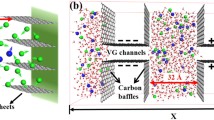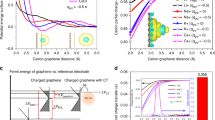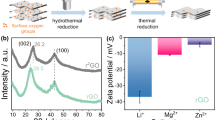Abstract
Electrical double layer (EDL) capacitors based on recently emergent graphene materials have shown several folds performance improvement compared to conventional porous carbon materials, driving a wave of technology breakthrough in portable and renewable energy storage. Accordingly, much interest has been generated to pursue a comprehensive understanding of the fundamental yet elusive double layer structure at the electrode/electrolyte interface. In this paper, we carried out comprehensive molecular dynamics simulations to obtain a comprehensive picture of how ion type, solvent properties, and charging conditions affect the EDL structure at the graphene electrode surface, and thereby its contribution to capacitance. We show that different symmetrical monovalent aqueous electrolytes M+X– (M+ = Na+, K+, Rb+, and Cs+; X– = F–, Cl–, and I–) indeed have distinctive EDL structures. Larger ions, such as, Rb+, Cs+, Cl–, and I–, undergo partial dehydration and penetrate through the first water layer next to the graphene electrode surfaces under charging. As such, the electrical potential distribution through the EDL strongly depends on the ion type. Interestingly, we further reveal that the water can play a critical role in determining the capacitance value. The change of dielectric constant of water in different electrolytes largely cancels out the variance in electric potential drop across the EDL of different ion type. Our simulation sheds new lights on how the interplay between solvent molecules and EDL structure cooperatively contributes to capacitance, which agrees with our experimental results well.

Similar content being viewed by others
References
Chmiola, J.; Yushin, G.; Gogotsi, Y.; Portet, C.; Simon, P.; Taberna, P. L. Anomalous increase in carbon capacitance at pore sizes less than 1 nanometer. Science 2006, 313, 1760–1763.
Huang, J. S.; Sumpter, B. G.; Meunier, V. A universal model for nanoporous carbon supercapacitors applicable to diverse pore regimes, carbon materials, and electrolytes. Chem.—Eur. J. 2008, 14, 6614–6626.
Cagle, C.; Feng, G.; Qiao, R.; Huang, J. S.; Sumpter, B. G.; Meunier, V. Structure and charging kinetics of electrical double layers at large electrode voltages. Microfluid. Nanofluid. 2010, 8, 703–708.
Feng, G.; Qiao, R.; Huang, J. S.; Sumpter, B. G.; Meunier, V. Atomistic insight on the charging energetics in subnanometer pore supercapacitors. J. Phys. Chem. C 2010, 114, 18012–18016.
Jiang, D.-E.; Jin, Z. H.; Wu, J. Z. Oscillation of capacitance inside nanopores. Nano Lett. 2011, 11, 5373–5377.
Wander, M. C. F.; Shuford, K. L. Electrolyte effects in a model system for mesoporous carbon electrodes. J. Phys. Chem. C 2011, 115, 4904–4908.
Górniak, R.; Lamperski, S. Investigation of the electrical double layer with a graphene electrode by the grand canonical Monte Carlo simulation. J. Phys. Chem. C 2014, 118, 3156–3161.
Punnathanam, S. N. A gibbs-ensemble based technique for Monte Carlo simulation of electric double layer capacitors (EDLC) at constant voltage. J. Chem. Phys. 2014, 140, 174110.
Jiang, D.-E.; Wu, J. Z. Microscopic insights into the electrochemical behavior of nonaqueous electrolytes in electric double-layer capacitors. J. Phys. Chem. Lett. 2013, 4, 1260–1267.
Vatamanu, J.; Borodin, O.; Smith, G. D. Molecular insights into the potential and temperature dependences of the differential capacitance of a room-temperature ionic liquid at graphite electrodes. J. Am. Chem. Soc. 2010, 132, 14825–14833.
Shim, Y.; Jung, Y.; Kim, H. J. Graphene-based supercapacitors: A computer simulation study. J. Phys. Chem. C 2011, 115, 23574–23583.
Kondrat, S.; Georgi, N.; Fedorov, M. V.; Kornyshev, A. A. A superionic state in nano-porous double-layer capacitors: Insights from Monte Carlo simulations. Phys. Chem. Chem. Phys. 2011, 13, 11359–11366.
Kondrat, S.; Kornyshev, A. Superionic state in double-layer capacitors with nanoporous electrodes. J. Phys.: Condens. Matter 2011, 23, 022201.
Feng, G.; Li, S.; Presser, V.; Cummings, P. T. Molecular insights into carbon supercapacitors based on roomtemperature ionic liquids. J. Phys. Chem. Lett. 2013, 4, 3367–3376.
DeYoung, A. D.; Park, S.-W.; Dhumal, N. R.; Shim, Y.; Jung, Y.; Kim, H. J. Graphene oxide supercapacitors: A computer simulation study. J. Phys. Chem. C 2014, 118, 18472–18480.
Vatamanu, J.; Borodin, O.; Smith, G. D. Molecular dynamics simulation studies of the structure of a mixed carbonate/LiPF6 electrolyte near graphite surface as a function of electrode potential. J. Phys. Chem. C 2012, 116, 1114–1121.
Vatamanu, J.; Cao, L. L.; Borodin, O.; Bedrov, D.; Smith, G. D. On the influence of surface topography on the electric double layer structure and differential capacitance of graphite/ ionic liquid interfaces. J. Phys. Chem. Lett. 2011, 2, 2267–2272.
Helmholtz, H. Ueber einige gesetze der vertheilung elektrischer ströme in körperlichen leitern mit anwendung auf die thierisch-elektrischen versuche. Annalen der Physik 1853, 165, 211–233.
Gouy, G. Constitution of the electric charge at the surface of an electrolyte. J. Phys. 1910, 9, 457–467.
Chapman, D. L. LI. A contribution to the theory of electrocapillarity. Philos. Mag. Ser. 6 1913, 25, 475–481.
Stern, H. O. Zur theorie der elektrolytischen doppelschicht. Z. Anorg. Allg. Chem. 1924, 30, 508–516.
Xia, J. L.; Chen, F.; Li, J. H.; Tao, N. J. Measurement of the quantum capacitance of graphene. Nat. Nanotechnol. 2009, 4, 505–509.
Wander, M. C. F.; Shuford, K. L. Molecular dynamics study of interfacial confinement effects of aqueous NaCl brines in nanoporous carbon. J. Phys. Chem. C 2010, 114, 20539–20546.
Feng, G.; Cummings, P. T. Supercapacitor capacitance exhibits oscillatory behavior as a function of nanopore size. J. Phys. Chem. Lett. 2011, 2, 2859–2864.
Wander, M. C. F.; Shuford, K. L. Alkali halide interfacial behavior in a sequence of charged slit pores. J. Phys. Chem. C 2011, 115, 23610–23619.
Feng, G.; Jiang, D.-E.; Cummings, P. T. Curvature effect on the capacitance of electric double layers at ionic liquid/ onion-like carbon interfaces. J. Chem. Theory Comput. 2012, 8, 1058–1063.
Kalluri, R. K.; Ho, T. A.; Biener, J.; Biener, M. M.; Striolo, A. Partition and structure of aqueous NaCl and CaCl2 electrolytes in carbon-slit electrodes. J. Phys. Chem. C 2013, 117, 13609–13619.
Reed, S. K.; Lanning, O. J.; Madden, P. A. Electrochemical interface between an ionic liquid and a model metallic electrode. J. Chem. Phys. 2007, 126, 084704.
Péan, C.; Merlet, C.; Rotenberg, B.; Madden, P. A.; Taberna, P.-L.; Daffos, B.; Salanne, M.; Simon, P. On the dynamics of charging in nanoporous carbon-based supercapacitors. ACS Nano 2014, 8, 1576–1583.
Merlet, C.; Péan, C.; Rotenberg, B.; Madden, P. A.; Simon, P.; Salanne, M. Simulating supercapacitors: Can we model electrodes as constant charge surfaces? J. Phys. Chem. Lett. 2013, 4, 264–268.
Wang, Z. X.; Yang, Y.; Olmsted, D. L.; Asta, M.; Laird, B. B. Evaluation of the constant potential method in simulating electric double-layer capacitors. J. Chem. Phys. 2014, 141, 184102.
Jorgensen, W. L. Quantum and statistical mechanical studies of liquids. 10. Transferable intermolecular potential functions for water, alcohols, and ethers. Application to liquid water. J. Am. Chem. Soc. 1981, 103, 335–340.
Ryckaert, J.-P.; Ciccotti, G.; Berendsen, H. J. C. Numerical integration of the cartesian equations of motion of a system with constraints: Molecular dynamics of n-alkanes. J. Comput. Phys. 1977, 23, 327–341.
Alexiadis, A.; Kassinos, S. Molecular simulation of water in carbon nanotubes. Chem. Rev. 2008, 108, 5014–5034.
MacKerell, A. D.; Bashford, D.; Bellott, M.; Dunbrack, R. L.; Evanseck, J. D.; Field, M. J.; Fischer, S.; Gao, J.; Guo, H.; Ha, S. et al. All-atom empirical potential for molecular modeling and dynamics studies of proteins. J. Phys. Chem. B 1998, 102, 3586–3616.
Foloppe, N.; MacKerell, A. D. All-atom empirical force field for nucleic acids: I. Parameter optimization based on small molecule and condensed phase macromolecular target data. J. Comput. Chem. 2000, 21, 86–104.
Dang, L. X. Fluoride-fluoride association in water from molecular dynamics simulations. Chem. Phys. Lett. 1992, 200, 21–25.
Dang, L. X.; Garrett, B. C. Photoelectron spectra of the hydrated iodine anion from molecular dynamics simulations. J. Chem. Phys. 1993, 99, 2972–2977.
Fasolino, A.; Los, J. H.; Katsnelson, M. I. Intrinsic ripples in graphene. Nat. Mater. 2007, 6, 858–861.
Yang, X. W.; Zhu, J. W.; Qiu, L.; Li, D. Bioinspired effective prevention of restacking in multilayered graphene films: Towards the next generation of high-performance supercapacitors. Adv. Mater. 2011, 23, 2833–2838.
Yang, X. W.; Cheng, C.; Wang, Y. F.; Qiu, L.; Li, D. Liquid-mediated dense integration of graphene materials for compact capacitive energy storage. Science 2013, 341, 534–537.
Ma, M. D.; Shen, L. M.; Sheridan, J.; Liu, J. Z.; Chen, C.; Zheng, Q. S. Friction of water slipping in carbon nanotubes. Phys. Rev. E 2011, 83, 036316.
Xiong, W.; Liu, J. Z.; Ma, M.; Xu, Z. P.; Sheridan, J.; Zheng, Q. S. Strain engineering water transport in graphene nanochannels. Phys. Rev. E 2011, 84, 056329.
Chen, C.; Ma, M.; Jin, K.; Liu, J. Z.; Shen, L. M.; Zheng, Q. S.; Xu, Z. P. Nanoscale fluid-structure interaction: Flow resistance and energy transfer between water and carbon nanotubes. Phys. Rev. E 2011, 84, 046314.
Conway, B. E. Electrochemical Supercapacitors: Scientific Fundamentals and Technological Applications (POD); Kluwer Academic/Plenum: New York, 1999.
Behrens, S. H.; Borkovec, M. Exact Poisson-Boltzmann solution for the interaction of dissimilar charge-regulating surfaces. Phys. Rev. E 1999, 60, 7040–7048.
Spohr, E. Molecular simulation of the electrochemical double layer. Electrochim. Acta 1999, 44, 1697–1705.
Crozier, P. S.; Rowley, R. L.; Henderson, D. Molecular dynamics calculations of the electrochemical properties of electrolyte systems between charged electrodes. J. Chem. Phys. 2000, 113, 9202–9207.
Wang, S.; Li, S.; Cao, Z.; Yan, T. Y. Molecular dynamic simulations of ionic liquids at graphite surface. J. Phys. Chem. C 2010, 114, 990–995.
Fedorov, M. V.; Kornyshev, A. A. Towards understanding the structure and capacitance of electrical double layer in ionic liquids. Electrochim. Acta 2008, 53, 6835–6840.
Bazant, M. Z.; Storey, B. D.; Kornyshev, A. A. Double layer in ionic liquids: Overscreening versus crowding. Phys. Rev. Lett. 2011, 106, 046102.
Feng, G.; Huang, J. S.; Sumpter, B. G.; Meunier, V.; Qiao, R. A “counter-charge layer in generalized solvents” framework for electrical double layers in neat and hybrid ionic liquid electrolytes. Phys. Chem. Chem. Phys. 2011, 13, 14723–14734.
Merlet, C.; Rotenberg, B.; Madden, P. A.; Taberna, P.-L.; Simon, P.; Gogotsi, Y.; Salanne, M. On the molecular origin of supercapacitance in nanoporous carbon electrodes. Nat. Mater. 2012, 11, 306–310.
Falk, K.; Sedlmeier, F.; Joly, L.; Netz, R. R.; Bocquet, L. Molecular origin of fast water transport in carbon nanotube membranes: Superlubricity versus curvature dependent friction. Nano Lett. 2010, 10, 4067–4073.
Yang, K.-L.; Yiacoumi, S.; Tsouris, C. Monte Carlo simulations of electrical double-layer formation in nanopores. J. Chem. Phys. 2002, 117, 8499–8507.
Marti, J.; Nagy, G.; Gordillo, M. C.; Guà rdia, E. Molecular simulation of liquid water confined inside graphite channels: Thermodynamics and structural properties. J. Chem. Phys. 2006, 124, 094703.
Cui, S. T.; Cochran, H. D. Molecular dynamics simulation of interfacial electrolyte behaviors in nanoscale cylindrical pores. J. Chem. Phys. 2002, 117, 5850–5854.
Hunter, R. J. Zeta Potential in Colloid Science: Principles and Applications; Academic Press: New York, 1988.
Schoch, R. B.; van Lintel, H.; Renaud, P. Effect of the surface charge on ion transport through nanoslits. Phys. Fluids 2005, 17, 100604.
Aaqvist, J. Ion-water interaction potentials derived from free energy perturbation simulations. J. Phys. Chem. 1990, 94, 8021–8024.
Richens, D. T. The Chemistry of Aqua Ions: Synthesis, Structure and Reactivity: A Tour through the Periodic Table of the Elements; Wiley: Chichester, New York, 1997.
Rajamani, S.; Ghosh, T.; Garde, S. Size dependent ion hydration, its asymmetry, and convergence to macroscopic behavior. J. Chem. Phys. 2004, 120, 4457–4466.
Mähler, J.; Persson, I. A study of the hydration of the alkali metal ions in aqueous solution. Inorg. Chem. 2012, 51, 425–438.
Kalluri, R. K.; Biener, M. M.; Suss, M. E.; Merrill, M. D.; Stadermann, M.; Santiago, J. G.; Baumann, T. F.; Biener, J.; Striolo, A. Unraveling the potential and pore-size dependent capacitance of slit-shaped graphitic carbon pores in aqueous electrolytes. Phys. Chem. Chem. Phys. 2013, 15, 2309–2320.
Magnussen, O. M. Ordered anion adlayers on metal electrode surfaces. Chem. Rev. 2002, 102, 679–726.
Feng, G.; Huang, J. S.; Sumpter, B. G.; Meunier, V.; Qiao, R. Structure and dynamics of electrical double layers in organic electrolytes. Phys. Chem. Chem. Phys. 2010, 12, 5468–5479.
Singh, R.; Rajput, N. N.; He, X. X.; Monk, J.; Hung, F. R. Molecular dynamics simulations of the ionic liquid [EMIM+][TFMSI–] confined inside rutile (110) slit nanopores. Phys. Chem. Chem. Phys. 2013, 15, 16090–16103.
Stoller, M. D.; Park, S.; Zhu, Y. W.; An, J.; Ruoff, R. S. Graphene-based ultracapacitors. Nano Lett. 2008, 8, 3498–3502.
Zhang, Y.; Feng, H.; Wu, X. B.; Wang, L. Z.; Zhang, A. Q.; Xia, T. C.; Dong, H. C.; Li, X. F.; Zhang, L. S. Progress of electrochemical capacitor electrode materials: A review. Int. J. Hydrogen Energy 2009, 34, 4889–4899.
Cheng, C.; Uhe, J.; Yang, X. W.; Wu, Y. Z.; Li, D. Multilayered graphene membrane as an experimental platform to probe nano-confined electrosorption. Prog. Nat. Sci.: Mater. Int. 2012, 22, 668–672.
Dimitrov, D. I.; Raev, N. D.; Semerdzhiev, K. I. Molecular dynamics simulations of the electrical double layer at 1 M potassium halide solution/Hg electrode interfaces. Phys. Chem. Chem. Phys. 2001, 3, 448–452.
Feng, G.; Qiao, R.; Huang, J. S.; Sumpter, B. G.; Meunier, V. Ion distribution in electrified micropores and its role in the anomalous enhancement of capacitance. ACS Nano 2010, 4, 2382–2390.
Kondrat, S.; Kornyshev, A.; Stoeckli, F.; Centeno, T. A. The effect of dielectric permittivity on the capacitance of nanoporous electrodes. Electrochem. Commun. 2013, 34, 348–350.
Fulton, R. L. The nonlinear dielectric behavior of water: Comparisons of various approaches to the nonlinear dielectric increment. J. Chem. Phys. 2009, 130, 204503–204512.
Yang, L.; Fishbine, B. H.; Migliori, A.; Pratt, L. R. Dielectric saturation of liquid propylene carbonate in electrical energy storage applications. J. Chem. Phys. 2010, 132, 044701.
Author information
Authors and Affiliations
Corresponding authors
Electronic supplementary material
Rights and permissions
About this article
Cite this article
Jiang, G., Cheng, C., Li, D. et al. Molecular dynamics simulations of the electric double layer capacitance of graphene electrodes in mono-valent aqueous electrolytes. Nano Res. 9, 174–186 (2016). https://doi.org/10.1007/s12274-015-0978-5
Received:
Revised:
Accepted:
Published:
Issue Date:
DOI: https://doi.org/10.1007/s12274-015-0978-5




